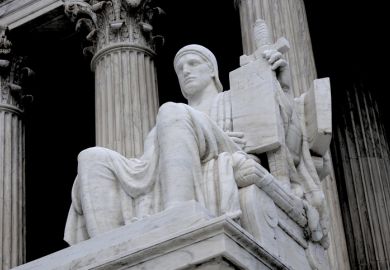The Supreme Court, like the American public, has long given higher education the benefit of the doubt. While a series of decisions over the past 45 years has gradually narrowed the scope of what could be considered in college admissions, the court has generally deferred to colleges, trusting in the alchemy that occurred behind closed doors as admissions officers decided who got in and who did not.
All that changed with the recent court ruling against Harvard and the University of North Carolina. The ruling did more than disallow race-conscious admissions policies; it signalled that higher education has lost another important ally. The majority of the justices joined the majority of the public in telling America’s colleges and universities: “We don’t have confidence in you any more.”
The decision could ripple across other areas of higher education because it threatens academic freedom itself. Since the height of the Cold War, the Supreme Court has treated academic freedom as “a special concern of the First Amendment”. Borrowing from a statement issued by South African scholars protesting against the racial segregation of universities under apartheid, the court wrote in 1957 that every college or university has “four essential freedoms…to determine for itself on academic grounds who may teach, what may be taught, how it shall be taught, and who may be admitted to study”.
This view of academic freedom led the court then to protect the free speech rights of instructors, including their right to express Marxist views. But in subsequent years, considerations of academic freedom factored into all the Supreme Court’s decisions involving universities’ race-conscious admissions policies. The court granted colleges and universities the freedom to select the students they educated, and it largely deferred to their evaluation of whether race-conscious admissions policies were necessary in the interest of serving a compelling government interest – in this case, the government interest in student body diversity.
The Supreme Court’s Harvard and UNC ruling left no doubt that the rules of the game were now being enforced by a very different set of referees. The six-member majority declared that they had had enough of colleges’ vague assurances. They dinged Harvard’s and UNC’s policies for lacking sufficiently measurable objectives, clear rationales for their definitions of racial categories or meaningful statements of when the need for the race-conscious admissions would end. The court had deferred to institutions’ judgements on such matters in past rulings in favour of the University of Michigan and the University of Texas.
In the majority opinion, Chief Justice Roberts wrote: “The universities’ main response to these criticisms is, essentially, ‘trust us’. None of the questions recited above need answering, they say, because the universities are ‘owed deference’ when using race to benefit some applicants but not others.” Driving home that no deference was forthcoming, he continued: “Universities may define their missions as they see fit. The Constitution defines ours.”
The lack of faith in colleges to do the right thing is reflected in public opinion. A new Gallup poll finds that only 36 per cent of Americans have “a great deal” or “quite a lot” of confidence in higher education, down from 57 per cent who held that opinion in 2015. Other polls have shown an increasing disregard for the economic value of higher education, with many respondents noting the high cost of college and scepticism about whether it is worth it.
The evidence is clear on this point: college graduates have better earnings on average than those without degrees. Nonetheless, institutions have resisted accountability for years. Colleges ask consumers to accept on faith that they teach students useful skills that will get them good jobs. College is too expensive and its outcomes too variable, however, to accept those assurances on trust alone.
The court said prospective students may still mention race in application essays in describing experiences that shaped their lives and character. But Roberts also warned that the court would be watching: universities cannot use such essays as an excuse to consider race in itself. Others are watching closely, too: the plaintiff in the cases, Students for Fair Admissions, has signalled that it is now considering filing lawsuits challenging race-conscious scholarships and the argument that service academies are exempt from the court’s decision.
The ongoing culture war only adds fuel to the fire, with conservatives attacking what they see as higher education’s “woke” agenda.
Colleges, in other words, are entering a new era of scrutiny, second-guessing and increased accountability. They had been allowed under law to operate behind a curtain – but, as the Supreme Court’s decision has shown, that era of trust is over.
Anthony P. Carnevale is director of the Georgetown Center on Education and the Workforce. Peter Schmidt is an education writer who covered affirmative action and academic freedom for The Chronicle of Higher Education. Both are co-authors of The Merit Myth: How Our Colleges Favor the Rich and Divide America (The New Press, 2020).
Register to continue
Why register?
- Registration is free and only takes a moment
- Once registered, you can read 3 articles a month
- Sign up for our newsletter
Subscribe
Or subscribe for unlimited access to:
- Unlimited access to news, views, insights & reviews
- Digital editions
- Digital access to THE’s university and college rankings analysis
Already registered or a current subscriber?








